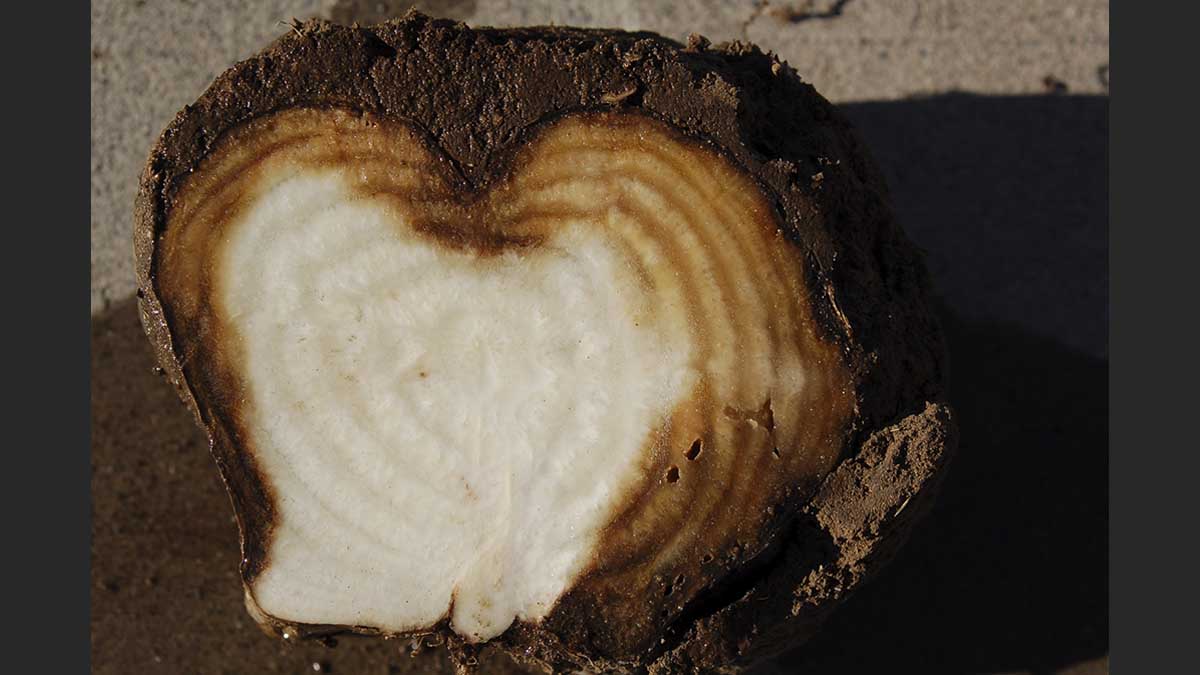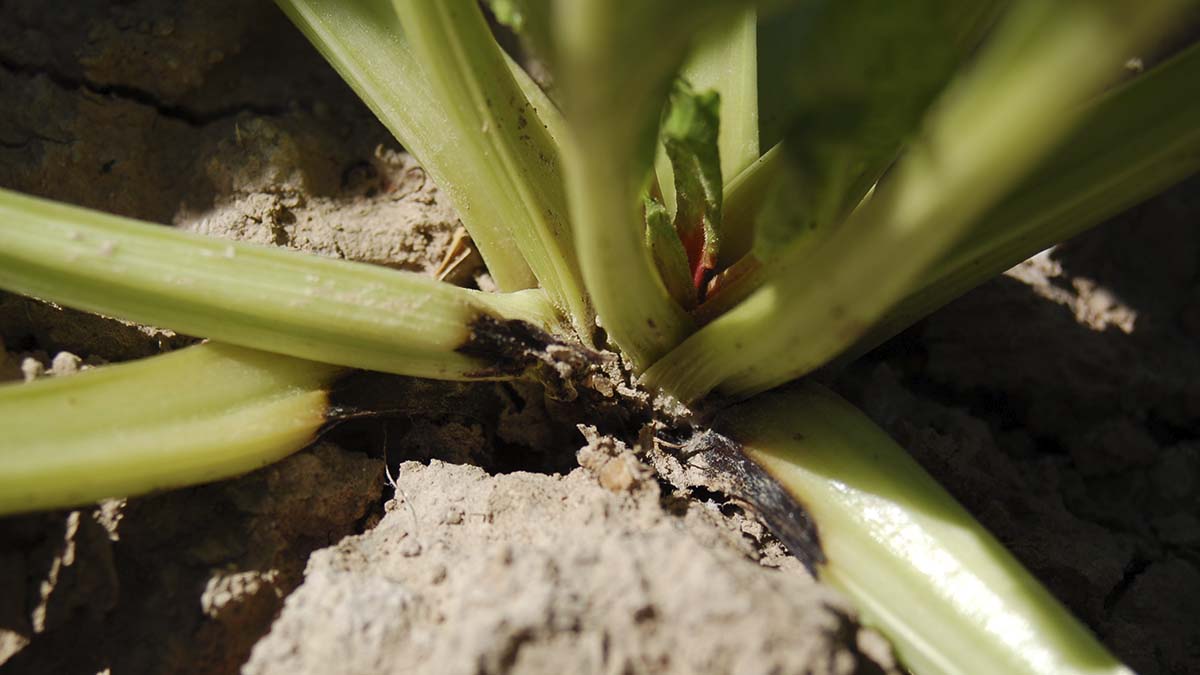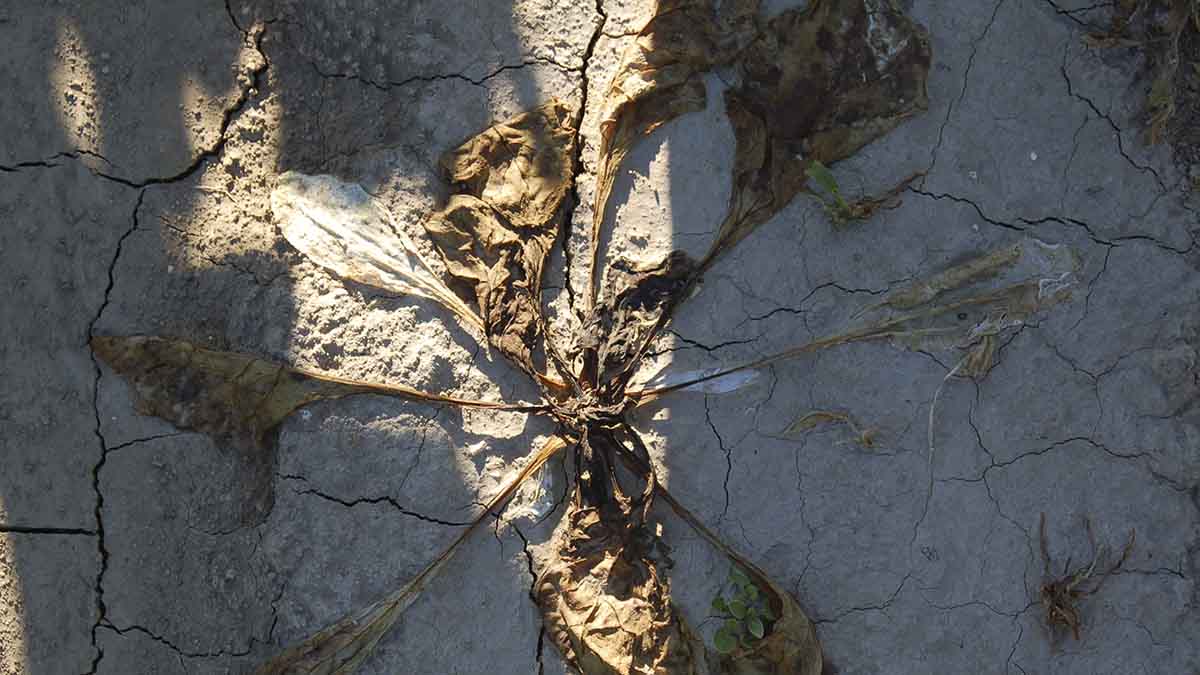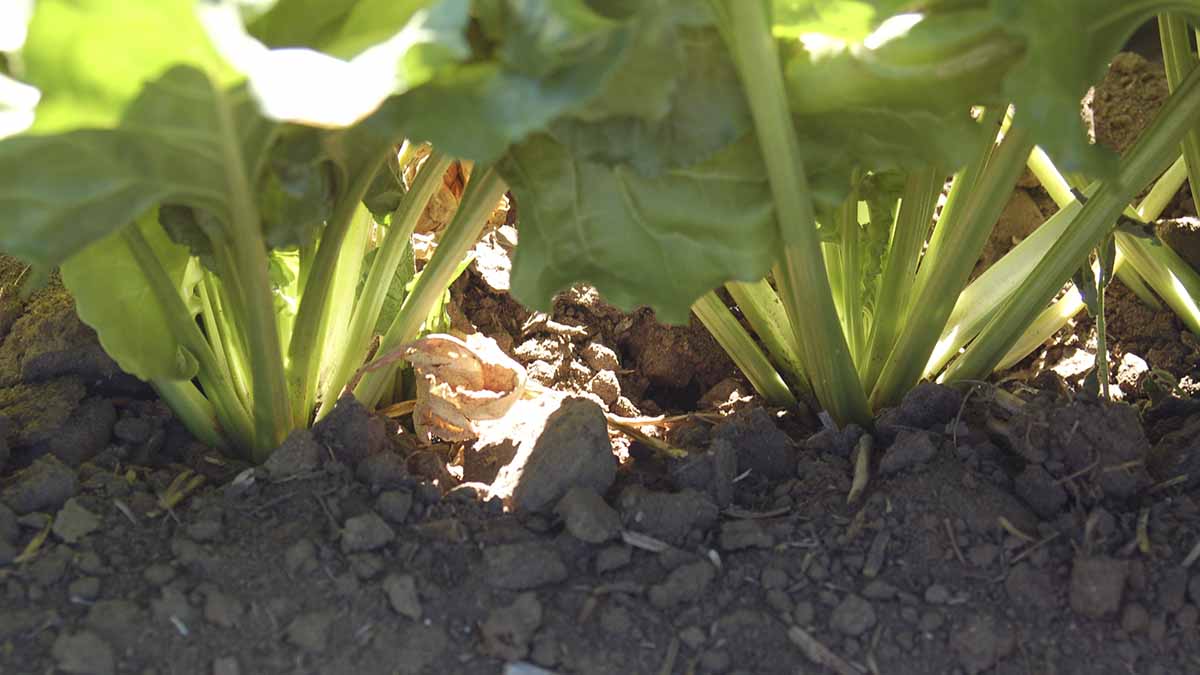Rhizoctonia Root and Crown Rot
Pest Common Name
- Disease name — Rhizoctonia root and crown rot
- Disease organism — Rhizoctonia solani Kühn
- Crops including sugar beet, bean, corn, wheat, potato, canola, others
- Vegetables and ornamentals
- Weeds including pigweed, lambsquarters and kochia
Rhizoctonia solani Kühn is a soilborne fungus that causes losses in all major sugar beet growing areas. Injury and stress (e.g., mechanical or insect feeding damage, water stress or nutrient stress) favor infection. Rhizoctonia affects sugar beets in a variety of ways:
Root and crown rot are the primary concern associated with Rhizoctonia infection in sugar beets in Idaho. Initial infection may begin anywhere on the root. Rhizoctonia-infected root tissue turns dark brown to black and remains firm (Figure 1). Infected tissue that is secondarily infected with other fungi or bacteria undergoes further discoloration, becomes soft and often appears wet (Figure 1). If bacterial infection advances, the smell of fermentation and bacterial ooze will often be evident. Foliar symptoms include formation of dark brown or black lesions on petiole bases, and the wilting and drying of the leaves (Figure 2). Leaves eventually collapse to the ground, though they remain attached to the rosette (Figure 3). Infection often occurs when soil is deposited into the crown or is excessively “hilled” into contact with the bases of petioles (Figure 4).




Seedings damping-off, usually occurs at the post-emergence stage, though occasionally pre-emergence as well can also occur due to Rhizoctonia infection. Sugar beet seedling damping-off due to Rhizoctonia is uncommon in Idaho due to cool soil temperatures during planting, but there may be a greater risk when fields have been replanted later in the season, into warmer soils. Seedlings infected with R. solani show a darkening of the tissues starting below the soil surface and spreading up to the hypocotyl. Seedlings usually wilt and die due to the infection.
Rhizoctonia foliar blight also impacts sugar beets but is not considered to be of economic importance in Idaho. In rare instances (later in the season when conditions are hot and wet) Rhizoctonia will cause malformation and discoloration of the heart leaves, brown cankers forming on petioles and the formation of leaf lesions with the appearance of being water soaked.
Biology
Rhizoctonia solani has a wide host range. The fungus can survive within living hosts, but also can persist on organic debris. Crop residues that are slow to decompose are often an important source of inoculum for R. solani infection and weeds (e.g., dandelion, kochia, lambsquarters and wild oat) are alternative hosts that also support the population of the fungus. Soil temperatures between 59- and 95-degrees Fahrenheit (15 and 35°C) allow germination and infection, but the optimal temperature range is from 77 and 91 degrees Fahrenheit (25–33°C).
Identification of R. solani can be accomplished by microscopically examining vegetative hyphae, as the fungus does not produce spores. For more information on identification from hyphae, consult “Rhizoctonia on Sugar Beet: Importance, Identification and Control in the Northwest, PNW629." The fungus also produces sclerotia, dark brown, barrel-shaped hyphal structures, that are visible to the naked eye.
Damage
Root rots, including Rhizoctonia, are the most important limiting factor for sugar beet production in many areas. Rhizoctonia is estimated to threaten or affect economic returns on 24% of sugar beet acres in the United States each year and causes an average of 2% yield loss. However, losses of 30-60% within a field are not uncommon and losses of up to 100% are possible. In Idaho, damage has historically been most severe in the Treasure Valley region, though more recently losses in the Magic Valley region have increased.
Root and crown rot causes stunting of beets, increases tare dirt from rotted beets and adhering soil, and causes losses in sucrose during storage. Less commonly, seedling damping-off can reduce stand density. Losses are most severe when soils are warm (77–91°F, 25–33°C), compacted and wet. As the conditions that favor Rhizoctonia root and crown rot also favor many other root rots, often more than one disease can infect the same field. If secondary infection by other fungi or bacteria occurs, additional losses of 15 to 65% and further sucrose losses during storage can be expected.
Monitoring
In season control of Rhizoctonia root and crown rot is difficult, and all management practices need to be applied early on. However, identifying affected areas and estimating disease severity is vital. Scouting efforts can be directed toward areas most likely to be infected by Rhizoctonia. Rhizoctonia may infect clusters of plants, but scattered infection is also possible. Initial infection can occur at the crown, as well as on the root surface at or directly below the soil line. Infection is most common near weedy areas containing alternative hosts such as pigweed, lambsquarters and kochia, and in fields previously planted in sugar beets, beans or corn.
Management
Primary Management Tactics
Promote crop health and minimize stress to decrease the likelihood of losses from Rhizoctonia. Avoid soil compaction and control soil moisture to avoid creating a favorable environment for Rhizoctonia. Control weeds.
Cultural
- A minimum of a three-year rotation should be used. If root rot is a problem, lengthen rotation to four to five years.
- Plant beets after non-host crops (e.g., cereals) to reduce root rot. Avoid planting beets after alfalfa, beans or corn.
- Plan crop rotations to maintain organic matter levels and to control weeds
- Promote decomposition of crop residues that may serve as colonization sites for R. solani. Chopping residues (particularly from grain crops) and letting them decompose before plowing under, and increasing the interval between plowing and planting are recommended.
- Supply adequate nitrogen while avoiding access
- Avoid over- and under-irrigation, maintaining an optimal soil moisture of -40 to -60 centibars (cbars) soil matric potential. If root rots have been a problem, irrigations should be scheduled when soil is as dry as possible without stressing the crop.
- Avoid soil compaction by:
- Controlling traffic and wheel tracks
- Increasing soil organic matter
- Rotating with deep-rooting crops while reducing tillage
- Considering fall bedding to reduce spring traffic when soils are often wet
- When hilling, avoid pushing soil into contact with petioles and into crowns (the most common points of initiation for infection)
- Maintain consistent plant spacing of 6 to 8 inches without larger gaps to keep soil cooler
- Control weeds that may serve as hosts (e.g., dandelion, kochia, lambsquarters, pigweed and wild oat)
- Consider planting tolerant varieties, though yield, quality and other diseases resistance traits should be taken into consideration.
Biological
- Biological products available to suppress Rhizoctonia can be found on the PNW Pest Management Handbooks webpage
Chemical
- In-furrow applications generally target and are most effective against seedling damping-off
- Banded applications before cultivation or between the four- and eight-leaf stages generally target and are most effective against root rot
- Recommendations for pesticides to use in the management of Rhizoctonia on sugar beets can be found by contacting local crop consultants, Cooperative Extension Service representatives or by visiting the PNW Pest Management Handbooks webpage
Further reading
- Harveson, R.M., Hanson, L.E., Hein, G.L. 2009. Compendium of Beet Diseases and Insects. 2nd Edition. St. Paul, MN: APS Press. https://apsjournals.apsnet.org/doi/book/10.1094/9780890546598
- Neher, O. and Gallian, J.J. 2011. Rhizoctonia on Sugar Beet: Importance, Identification and Control in the Northwest. Pacific Northwest Extension Publication. PNW629, https://www.uidaho.edu/extension/publications/publication-detail?id=pnw0629
Pesticide Warning
Always read and follow the instructions printed on the pesticide label. The pesticide recommendations in this University of Idaho webpage do not substitute for instructions on the label. Pesticide laws and labels change frequently and may have changed since this publication was written. Some pesticides may have been withdrawn or had certain uses prohibited. Use pesticides with care. Do not use a pesticide unless the specific plant, animal or other application site is specifically listed on the label. Store pesticides in their original containers and keep them out of the reach of children, pets and livestock.
Trade Names — To simplify information, trade names have been used. No endorsement of named products is intended nor is criticism implied of similar products not mentioned.
Groundwater — To protect groundwater, when there is a choice of pesticides, the applicator should use the product least likely to leach.
- Figures 1-4. Oliver T. Neher
Desiree Wickwar, Entomologist, IPM Project Manager
Oliver T. Neher, Plant Pathologist, ASC
2023










